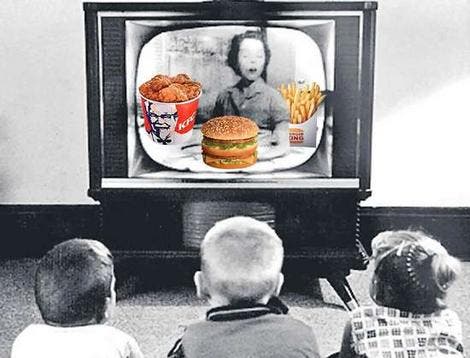It’s no secret that TV food commercials stimulate pleasure and reward centers in the brain, after all advertisers wouldn’t pay big money for them to air if they didn’t entice people to order more. In fact, food advertising has increased dramatically over the past 30 years. Teenagers are exposed on average to 13 food commercials on any given day. At the same time, childhood and adolescent obesity in the US has been on the rise fast and worrisome, so we can’t help but notice the connection. Now, researchers at Dartmouth found overweight teens are disproportionately affected by TV food commercials, as key brain regions that control pleasure, taste and – most surprisingly – the mouth are all much more stimulated than those teens with less body fat. The findings are important since they suggest overweight teens exposed to this kind of environment will experience further difficulties when they try to lose weight. A further insight is that dietary plans should also target subsequent thinking concerning eating food, not just the temptation.

The percentage of children aged 6–11 years in the United States who were obese increased from 7% in 1980 to nearly 18% in 2012. Similarly, the percentage of adolescents aged 12–19 years who were obese increased from 5% to nearly 21% over the same period, according to the CDC. Previously, ZME Science reported a number of studies related to TV advertisement, food and obesity in children and adolescents. For instance, one study found that the main reason people tend to overeat might be the response to a Pavlovian conditional reflex (McDonalds logos prompting people to immediately feel “hungry”). What’s worrisome are also the sly tactics employed by the industry, like marketing foods endorsed by athletes, despite over 90% of these brands are actually junk food. Long story short, exposure to food marketing promotes eating habits that contribute to obesity, children most vulnerable of all. What’s despicable however is that it all sounds more and more each day like an addiction problem, instead of a dietary choice.
The Dartmouth researchers used functional magnetic resonance imaging (fMRI) while participants – overweight and healthy-weight adolescents ages 12-16 – were watching some episodes of the “The Big Bang Theory,” a popular age-appropriate TV series. The teens were not aware of the study’s objective. From time to time, TV food commercials as well as non-food commercials were aired. The fMRI readings showed that brain regions involved in attention and focus (occipital lobe, precuneus, superior temporal gyri and right insula) and in processing rewards (nucleus accumbens and orbitofrontal cortex) were more strongly active when the food commercials were viewed, more so than non-food commercials. Adolescents with higher body fat showed greater reward-related activity than those with less body fat, particularly in regions associated with taste perception. What’s really surprising was that the food commercials also activated parts of the brains that control the mouth, its movements and perception. What’s more, the researchers played genuine commercials like those aired on live TV by McDonald’s and Burger King, so the findings must be closer to reality.
“This finding suggests the intriguing possibility that overweight adolescents mentally simulate eating while watching food commercials,” says lead author Kristina Rapuano, a graduate student in Dartmouth’s Brain Imaging Lab. “These brain responses may demonstrate one factor whereby unhealthy eating behaviors become reinforced and turned into habits that potentially hamper a person’s ability lose weight later in life.”

So, the teens aren’t just tempted to eat food, they actually unconsciously simulate what it would be like to munch on some chicken wings or burger. Dietary planers should take this into serious consideration. It’s not just temptation activated by reward centers in the brain that makes it hard for kids to follow a diet, but also a coupled bodily movement that’s always a sign of an eating habit or disorder. Findings appeared in the journal Cerebral Cortex.
“Unhealthy eating is thought to involve both an initial desire to eat a tempting food, such as a piece of cake, and a motor plan to enact the behavior, or eating it,” Rapuano says. “Diet intervention strategies largely focus on minimizing or inhibiting the desire to eat the tempting food, with the logic being that if one does not desire, then one won’t enact. Our findings suggest a second point of intervention may be the somatomotor simulation of eating behavior that follows from the desire to eat. Interventions that target this system, either to minimize the simulation of unhealthy eating or to promote the simulation of healthy eating, may ultimately prove to be more useful than trying to suppress the desire to eat.”






